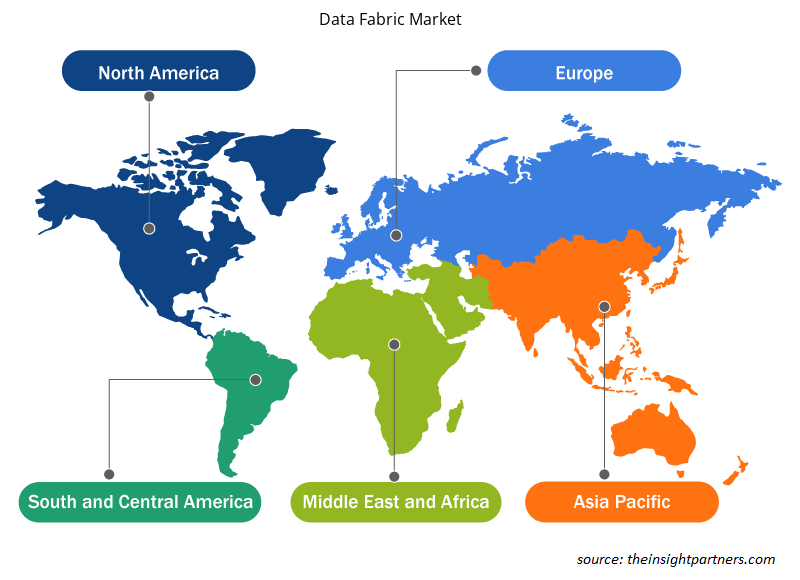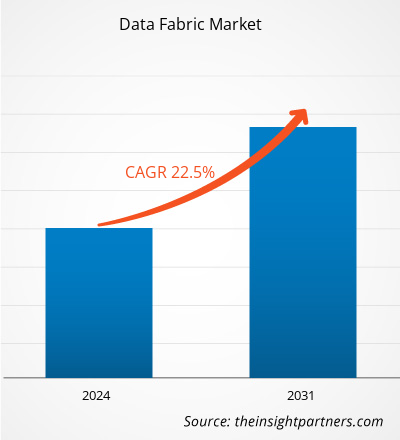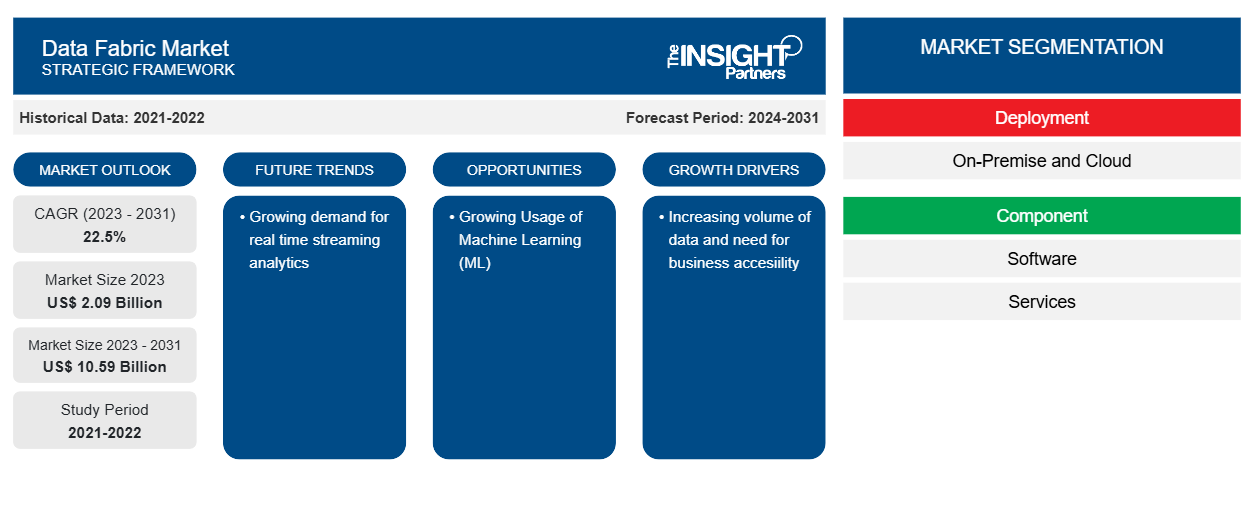Si prevede che il mercato Data Fabric crescerà da 2,09 miliardi di dollari nel 2023 a 10,59 miliardi di dollari entro il 2031; si prevede che si espanderà a un CAGR del 22,5% dal 2023 al 2031. Si prevede che la crescente domanda di analisi di streaming in tempo reale sarà una tendenza chiave nel mercato.
Analisi di mercato del Data Fabric
Il data fabric offre virtualizzazione dei dati, consentendo alle aziende di implementare un accesso senza interruzioni ai dati rendendoli accessibili a tutti. Con l'implementazione del data fabric, gli utenti aziendali possono accedere ai dati con una partecipazione minima dell'IT, con conseguente ambiente più rapido e semplice per l'accesso e lo scambio dei dati. Un data fabric logico ben progettato centralizza la sicurezza essenziale e la gestione dei dati. Pertanto, si prevede che il mercato del data fabric crescerà durante il periodo di previsione.
Panoramica del mercato del Data Fabric
Data Fabric è un sistema completo di integrazione e gestione dei dati che include architettura , strumenti di gestione e integrazione dei dati e dati condivisi per assistere le aziende nella gestione dei propri dati. Un data fabric offre un'esperienza utente unica e coerente e un accesso ai dati in tempo reale a ogni membro della rete globale di un'organizzazione. Data fabric è destinato ad assistere le aziende nella risoluzione di problemi di dati complessi e casi d'uso gestendo i dati su una varietà di applicazioni, piattaforme e posizioni. Data fabric fornisce accesso e condivisione dei dati senza attriti in un ambiente di dati disperso.
Personalizza questo report in base alle tue esigenze
Riceverai la personalizzazione gratuita di qualsiasi report, comprese parti di questo report, o analisi a livello nazionale, pacchetto dati Excel, oltre a usufruire di grandi offerte e sconti per start-up e università
-
Scopri le principali tendenze di mercato in questo rapporto.Questo campione GRATUITO includerà analisi di dati che spaziano dalle tendenze di mercato alle stime e alle previsioni.
Driver e opportunità di mercato del Data Fabric
Aumento del volume dei dati per favorire la crescita del mercato
Ogni organizzazione incentrata sui dati richiede un approccio completo che affronti tempo, spazio, vari tipi di software e posizioni dei dati. I dati devono essere disponibili a coloro che ne hanno bisogno, anziché essere nascosti dietro firewall o sparsi in più luoghi. Le aziende richiedono una soluzione dati sicura, efficiente, coerente e a prova di futuro per migliorare la loro efficienza operativa. Pertanto, si prevede che la domanda di data fabric crescerà durante il periodo di previsione.
Crescente utilizzo dell'apprendimento automatico (ML)
Gli algoritmi ML possono monitorare le pipeline di dati e suggerire collegamenti e integrazioni rilevanti . Questi algoritmi estraggono informazioni dai dati mentre sono collegati alla struttura dei dati, esaminano tutti i dati aziendali e trovano collegamenti e correlazioni rilevanti. Fornire dati è uno degli aspetti più dispendiosi in termini di tempo nell'addestramento di un modello ML. La progettazione di Data Fabric rende i modelli ML più efficienti riducendo i tempi di preparazione dei dati. Migliora inoltre l'usabilità dei dati preparati in varie applicazioni e modelli. Le aziende distribuiscono i dati in locale, nel cloud e nell'IoT . La struttura dei dati consente un accesso limitato ai dati sicuri e migliora i processi ML. Pertanto, si prevede che l'applicazione di ML in Data Fabric alimenterà la crescita del mercato durante il periodo di previsione.
Tessuto di dati
Analisi della segmentazione del rapporto di mercato
I segmenti chiave che hanno contribuito alla derivazione dell'analisi di mercato di Data Fabric sono la copertura per distribuzione, componente, soluzione e utente finale.
- In base all'implementazione, il mercato è diviso in on-premise e cloud. Il segmento cloud ha guidato il mercato nel 2023.
- In base ai componenti, il mercato si divide in software e servizi
- In base alla soluzione, il mercato è suddiviso in scoperta dei dati, inserimento dei dati, orchestrazione dei dati, accesso ai dati del fabric, gestione dei dati e gestione del fabric e
- Sulla base degli utenti finali, il mercato è suddiviso in BFSI, IT e telecomunicazioni, vendita al dettaglio, assistenza sanitaria e farmaceutica e altri
Analisi della quota di mercato di Data Fabric per area geografica
In base alla regione, il mercato è segmentato in Nord America, Europa, Asia Pacifico, Medio Oriente e Africa, Sud e Centro America.
La regione nordamericana ha detenuto una quota importante del mercato del data fabric nel 2023 e si prevede che crescerà a un CAGR sostanziale durante il periodo di previsione. Questa crescita può essere attribuita alla presenza di numerosi market plater e all'adozione precoce dell'adozione tecnologica. Inoltre, si prevede che la regione Asia-Pacifico crescerà al CAGR più rapido durante il periodo di previsione. Questa crescita può essere attribuita al crescente numero di data center e alla crescente digitalizzazione.
Approfondimenti regionali sul mercato Data Fabric
Le tendenze regionali e i fattori che influenzano il mercato Data Fabric durante il periodo di previsione sono stati ampiamente spiegati dagli analisti di Insight Partners. Questa sezione discute anche i segmenti e la geografia del mercato Data Fabric in Nord America, Europa, Asia Pacifico, Medio Oriente e Africa e America meridionale e centrale.

- Ottieni i dati specifici regionali per il mercato Data Fabric
Ambito del rapporto di mercato di Data Fabric
| Attributo del report | Dettagli |
|---|---|
| Dimensioni del mercato nel 2023 | 2,09 miliardi di dollari USA |
| Dimensioni del mercato entro il 2031 | 10,59 miliardi di dollari USA |
| CAGR globale (2023-2031) | 22,5% |
| Dati storici | 2021-2022 |
| Periodo di previsione | 2024-2031 |
| Segmenti coperti |
Per distribuzione
|
| Regioni e Paesi coperti |
America del Nord
|
| Leader di mercato e profili aziendali chiave |
|
Densità degli attori del mercato: comprendere il suo impatto sulle dinamiche aziendali
Il mercato del Data Fabric Market sta crescendo rapidamente, spinto dalla crescente domanda degli utenti finali dovuta a fattori quali l'evoluzione delle preferenze dei consumatori, i progressi tecnologici e una maggiore consapevolezza dei vantaggi del prodotto. Con l'aumento della domanda, le aziende stanno ampliando le loro offerte, innovando per soddisfare le esigenze dei consumatori e capitalizzando sulle tendenze emergenti, il che alimenta ulteriormente la crescita del mercato.
La densità degli operatori di mercato si riferisce alla distribuzione di aziende o società che operano in un particolare mercato o settore. Indica quanti concorrenti (operatori di mercato) sono presenti in un dato spazio di mercato in relazione alle sue dimensioni o al valore di mercato totale.
Le principali aziende che operano nel mercato Data Fabric sono:
- Tecnologie Denodo
- Società IBM
- Società Informatica
- K2Visualizza
- NetApp, Inc.
- Società Oracle
Disclaimer : le aziende elencate sopra non sono classificate secondo un ordine particolare.

- Ottieni una panoramica dei principali attori del mercato Data Fabric
Notizie di mercato e sviluppi recenti di Data Fabric
Il mercato Data Fabric viene valutato raccogliendo dati qualitativi e quantitativi dopo la ricerca primaria e secondaria, che include importanti pubblicazioni aziendali, dati associativi e database. Di seguito sono elencati alcuni degli sviluppi nel mercato Data Fabric:
- LigaData, un fornitore leader nel panorama della tecnologia delle telecomunicazioni, sta rivoluzionando il settore dell'analisi dei dati delle telecomunicazioni con il lancio del suo nuovo LigaData Telecom Data Fabric 4.0 e delle app LigaData Telecom AI. Questi nuovi prodotti consentono alle aziende di telecomunicazioni e ai fornitori di servizi di comunicazione nelle loro iniziative di trasformare le loro attività da aziende di telecomunicazioni tradizionali in aziende di tecnologia agili basate su dati e AI, guidando al contempo la crescita dei ricavi, mantenendo la quota di mercato e migliorando l'esperienza del cliente. (Fonte: LigaData, comunicato stampa, febbraio 2024)
Copertura e risultati del rapporto di mercato di Data Fabric
Le previsioni di mercato di Data Fabric sono stimate in base a vari risultati di ricerche secondarie e primarie, come pubblicazioni aziendali chiave, dati di associazioni e database. Il rapporto di mercato "Data Fabric Market Size and Forecast (2021–2031)" fornisce un'analisi dettagliata del mercato che copre le seguenti aree:
- Dimensioni e previsioni del mercato Data Fabric a livello globale, regionale e nazionale per tutti i segmenti di mercato chiave coperti dall'ambito
- Tendenze del mercato di Data Fabric, nonché dinamiche di mercato quali driver, vincoli e opportunità chiave
- Analisi dettagliata delle cinque forze PEST/Porter e SWOT
- Analisi di mercato di Data Fabric che copre le principali tendenze di mercato, il quadro globale e regionale, i principali attori, le normative e i recenti sviluppi del mercato
- Analisi del panorama industriale e della concorrenza che copre la concentrazione del mercato, l'analisi della mappa di calore, i principali attori e gli sviluppi recenti nel mercato Data Fabric
- Profili aziendali dettagliati.
- Analisi storica (2 anni), anno base, previsione (7 anni) con CAGR
- Analisi PEST e SWOT
- Valore/volume delle dimensioni del mercato - Globale, Regionale, Nazionale
- Industria e panorama competitivo
- Set di dati Excel
Report recenti
Rapporti correlati
Testimonianze
Motivo dell'acquisto
- Processo decisionale informato
- Comprensione delle dinamiche di mercato
- Analisi competitiva
- Analisi dei clienti
- Previsioni di mercato
- Mitigazione del rischio
- Pianificazione strategica
- Giustificazione degli investimenti
- Identificazione dei mercati emergenti
- Miglioramento delle strategie di marketing
- Aumento dell'efficienza operativa
- Allineamento alle tendenze normative























 Ottieni un campione gratuito per - Mercato del Data Fabric
Ottieni un campione gratuito per - Mercato del Data Fabric